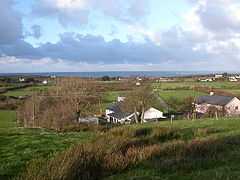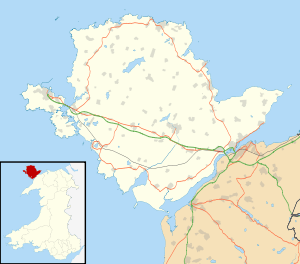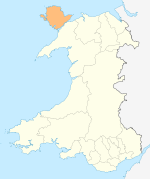Llaneilian
| Llaneilian | |
 Henblas |
|
 Llaneilian |
|
| Population | 1,192 (2001) |
|---|---|
| OS grid reference | SH4792 |
| Community | Llaneilian |
| Principal area | Anglesey |
| Ceremonial county | Gwynedd |
| Country | Wales |
| Sovereign state | United Kingdom |
| Post town | AMLWCH |
| Postcode district | LL68 |
| Dialling code | 01407 |
| Police | North Wales |
| Fire | North Wales |
| Ambulance | Welsh |
| EU Parliament | Wales |
| UK Parliament | Ynys Môn |
| Welsh Assembly | Ynys Môn |
Coordinates: 53°24′25″N 4°17′46″W / 53.407°N 4.296°W
Llaneilian is a village and community in the Welsh county of Anglesey. It is located in the north east of the island, 2.2 miles (3.5 km) east of Amlwch, 16.5 miles (26.6 km) north west of Menai Bridge and 12.5 miles (20.1 km) north of Llangefni. The community includes the villages of Dulas, Llaneilian, Pengorffwysfa and Penysarn, and at the 2001 census had a population of 1,192.[1] The parish is crowned by its hill, Mynydd Eilian (177 metres), a HuMP, popular with walkers and ramblers (the Anglesey Coastal Path navigates most of the parish's coastline - all of which is classed as an Area of Outstanding Natural Beauty), and its beach, Traeth Eilian, which is popular with holidaymakers and for watersport activities. At the north easternmost point is Point Lynas,(on a clear day from the north coast of Anglesey the Isle of Man is visible with the streetlights of Douglas, Isle of Man visible on the Horizon), while Ynys Dulas lies off the North East coast of the island, east of Dulas Bay.

Capital of the Gwynedd Kingdom
The parish contains the remains of Llys Caswallon[2] the site of the court of 5th Century King of Gwynedd Cadwallon Lawhir ap Einion - the third generation of the dynasty of Gwynedd, being the grandson of Cunedda, the progenitor of the royal dynasty of Gwynedd. This Lineage led to the famed reign of Rhodri the Great, who brought the kingdoms of Gwynedd, Powys and Seisyllwg under his control, and fought the threats of the Anglo Saxons and Vikings,[3] and who was killed on the island of Anglesey in 854AD. Later, this lineage led to possibly the most well known of all the medieval kings of Wales, Hywel Dda,[4] who came to rule most of Wales, and became synonymous with the codification of medieval Welsh law which became famed for a reputation of justice and early recognition of women's rights. His legacy endured in the form of his laws, which remained in active use throughout Wales until the appointed date of implementation of the Laws in Wales Acts 1535–1542 of Henry VIII of England who asserted his royal descent by blood-line from the House of Aberffraw, via Rhodri Mawr via Hywel Dda. It was this claim to this ancient Brittonic lineage by a British monarch that led to a widespread feeling of the fulfilment of the myth of the Mab Darogan, a messianic figure of Welsh legend destined to reclaim Britain for the Celtic inhabitants. The legacy of this lineage is represented in the main office buildings of the National Assembly for Wales being named "Tŷ Hywel" (the House of Hywel), within which the former debating chamber of the National Assembly for Wales has been converted into a youth debating chamber, the first of its kind in Europe, named "Siambr Hywel" (Hywel's Chamber) after Hywel Dda. The Coat of Arms of this dynasty is represented on the Royal Badge of Wales which appears on Acts of the National Assembly for Wales passed by the National Assembly for Wales.
Notible Buildings

Saint Eilian's Church is Grade I listed.[5] A Celtic clas church, it has a 12th-century tower, 14th-century chapel and a nave and chancel dating from the 15th century. In the chancel is a rare 15th-century rood screen, and there are traces of post-medieval wall paintings. A painting of a skeleton bears the inscription "Colyn angau yw pechod" (English: The sting of death is sin).[6] The Church is named after Saint Eilian. Saint Eilian of Rome also known as Eilian of Anglesey was a 6th-century Saint[7] Saint Eilian(Eilianus) came from Rome to Britain, where he lived as a hermit in the area north of Anglesey, and venerably reposed in peace. (His feast day is 13 January).
At Dulas is Saint Gwenllwyfo's Church, a mid-19th-century building designed by Henry Kennedy of Bangor. It is Grade II* listed. The nave and chancel contain 15th and 16th century Flemish stained glass, which had been removed from former Roman Catholic churches taken over by Protestants, who considered the images theologically unsound. Other examples are found at the Victoria and Albert Museum, the Burrell Collection in Glasgow, and the Metropolitan Museum of Art in New York.[8]
The refuge tower on Ynys Dulas was built in 1821 by James Hughes of Llysdulas as a refuge for shipwrecked sailors. It was stocked with essential foodstuffs to enable those stranded to survive until rescuers arrived.[9]
References
- ↑ "Census 2001: Parish Headcounts: Isle of Anglesey". Neighbourhood Statistics. Office for National Statistics. Retrieved 18 April 2013.
- ↑
- ↑
- ↑
- ↑ "Chapel of St. Mary (Tal-y-llyn) and churchyard walls, Aberffraw". British Listed Buildings. Retrieved 11 January 2014.
- ↑ "St Eilian's Church". Coflein. Royal Commission on the Ancient and Historical Monuments of Wales. Retrieved 18 April 2013.
- ↑ Great Synaxaristes: O Aγιος Eϊλιανoς Eκ Ρώμης. 12 Ιανουαρίου. ΜΕΓΑΣ ΣΥΝΑΞΑΡΙΣΤΗΣ.
- ↑ "Church of St Gwenllwyfo". Historic Wales. Cadw. Retrieved 18 April 2013.
- ↑ "Dulas Island Refuge Tower". Coflein. Royal Commission on the Ancient and Historical Monuments of Wales. Retrieved 19 April 2013.
External links
![]() Media related to Llaneilian at Wikimedia Commons
Media related to Llaneilian at Wikimedia Commons
- A Vision of Britain Through Time
- British Listed Buildings
- Genuki
- Geograph
- Office for National Statistics
- Kings of Gwynedd#Gwynedd
| ||||||||||||||||||||||||||||
| ||||||
